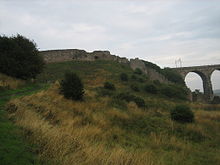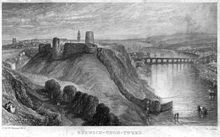Berwick Castle
Berwick Castle is a ruined castle in Berwick-upon-Tweed in the English county of Northumberland .
history
The castle was built in the 12th century by Scottish King I. David built. Between 1296 and 1298, King Edward I of England had the castle rebuilt and fortified the city before it was returned to Scotland. In November 1292 King Edward announced his arbitration in favor of John Balliol in the dispute between him and Robert the Bruce over the Crown of Scotland in front of the assembled English Parliament and many nobles from Scotland. In 1330 Domino Roberto de Lawedre of The Bass , described as “sexton or guardian of the marshes and the castle of Berwick-upon-Tweed”, received the sum of £ 33.6s, 8d apparently at the end of his employment there and again the same amount from the Scottish Treasury Secretary. The town and castle changed hands several times during the various Anglo-Scottish conflicts.
For 1464, the Exchequer Rolls of Scotland show that Robert Lauder of Edrington received £ 20 for repairs to Berwick Castle. In the 16th century, at the time of Elizabeth I , the walls were reinforced by the addition of two semicircular artillery flanking towers, one on the river side and the other at the corner of the curtain wall .
The castle's location in the contested borderland between England and Scotland made it one of the most important fortifications on the British Isles and it can look back on an eventful history. As a major tactical target in the region, it was captured several times by both the English and the Scots, often suffering severe damage in the process. Edward I of England used it as his headquarters during his invasions of Scotland. The castle also changed hands under less violent circumstances, e.g. B. when the English King Richard the Lionheart sold them to the Scots in order to finance his third crusade with the proceeds . Finally, in the last week of August 1482, the castle fell into English hands. After the invasion of Scotland under a pact with the Prince of Albany , Richard, Earl of Gloucester , took the castle of Patrick Hepburn, Lord Hailes .
The construction of modern fortress walls around Berwick in the 16th century rendered the castle useless and its further history is one of steady decline. Large parts were used as a quarry. In particular, this happened in the Commonwealth era for the construction of the Trinity Church in Berwick. In the 19th century, the Great Hall and much of what was left were demolished to make way for Berwick-upon-Tweed train station. The platforms are now where, in 1296, King Eduard Lehenseide accepted what can be read on a large plaque from the Scottish nobility.
The most important parts of the castle that have survived to this day are the White Wall from the end of the 13th century and the steep, long flight of stairs called Brakeneck Stairs . They are managed by English Heritage .
Owner of the castle
- Sir William Douglas, 1294–1296, surrendered to Edward I of England after the Berwick massacre
- Maurice de Berkeley, 2nd Baron Berkeley , English governor, ca.1314
- Edmond de Caillou, Gascognan governor of the English, died in 1316 at the Battle of Skaithmuir.
- Sir Robert Lauder from The Bass , about 1330.
- Robert Lauder of Edrington, later Robert Lauder of The Bass, 1461 / 2-1474.
- David, Earl of Crawford , 1474-1478.
- Sir Robert Lauder of Edrington, Knt., 1478-1482.
- Sir Patrick Hepburn, 1st Lord Hailes , 1482 (last Scottish governor).
- Sir William Drury (d. 1579), Marshal of Berwick-upon-Tweed, until 1564.
- Francis Russell, 2nd Earl of Bedford , appointed 1564.
- Sir George Bowes of Streatlam, County Durham (d. 1580), Marshal of Berwick. In 1568 he escorted Mary Queen of Scots from Carlisle to Bolton Castle . His sister Margery married John Knox .
Individual evidence
- ↑ John Stuart LL.D., George Burnett Lord Lyon King of Arms : The Exchequer Rolls of Scotland . Volume 1, 1264-1359, Edinburgh 1878. pp. 279, 313, 339.
swell
- Photos of Berwick Castle. NorthOfTheTyne.co.uk
- '' Berwick Castle ''. CastleUK.net
- Plantagenet Somerset Fry: The David & Charles Book of Castles . David & Charles, 1980. ISBN 0-7153-7976-3
- John Hill Burton: The History of Scotland . Edinburgh 1874. Volume IV. Pp. 364-365, v. pps: 68, 71, 73, 115, 120, 257 and 365, for Sir William Drury
- Lord Eustace Percy: John Knox . London 1937. p. 165.
Web links
Coordinates: 55 ° 46 ′ 30 ″ N , 2 ° 0 ′ 46.8 ″ W.


